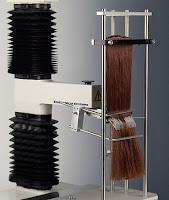What’s behind the trend? Consumers are demanding products that they perceive are better for their bodies, families, and the environment. Market research shows consumers now rank natural ingredients and environmental impact ahead of brand
recognition and product descriptions. They expect personalised products from a company whose values align with their own. Food containing nothing artificial once qualified as acceptable, but according to a 2017 survey, shoppers now look for labels with less sugar, more protein, and fewer ingredients with recognisable names.
 |
| Lipstick/Lip balm harness test using a P/2 probe |
One of the biggest challenges that manufacturers face when working towards “clean label” for their products is reformulating an existing product or formulating a new one using “clean label” ingredients. Providing a clean label for such items requires formulators to consider new ways of making safer, sustainable ingredients. While consumers want clean label products, they are not generally also willing to compromise on product performance. Texture analysis can greatly speed up the reformulation process and new product development by providing quantifiable, repeatable and accurate data on the physical properties of a product.
 |
| Hair Combability Rig |
• Hardness of lipstick, lip balm, wax, false nails, soaps, creams, and eye shadows
• Firmness and friction of deodorants solids, roll-ons, and antiperspirants
• Hair combability and bend strength before and after conditioning and treatments
• Hair friction, smoothness, flexibility and stiffness
• Compaction strength, cohesion and payout of eye shadow and face powders
• Claims validation for skin firming and anti-aging products
• Spreadability, stickiness and curing of any product
Additionally, texture analysis is useful in validating product claims which can help manufacturers differentiate their products. If you are considering clean labelling your formulations, see the range of typical examples in action here.
Stable Micro Systems can help out with many areas of efficacy testing. To find out more, contact us today.
We can design and manufacture probes or fixtures for the TA.XTplus texture analyser that are bespoke to your sample and its specific measurement.
Once your measurement is performed, our expertise in its graphical interpretation is unparalleled. Not only can we develop the most suitable and accurate method for the testing of your sample, but we can also prepare analysis procedures that obtain the desired parameters from your curve and drop them into a spreadsheet or report designed around your requirements.
For more information on how to measure texture, please visit the Texture Analysis Properties section on our website.
 The TA.XTplus texture analyser is part of a family of texture analysis instruments and equipment from Stable Micro Systems. An extensive portfolio of specialist attachments is available to measure and analyse the textural properties of a huge range of food products. Our technical experts can also custom design instrument fixtures according to individual specifications.
The TA.XTplus texture analyser is part of a family of texture analysis instruments and equipment from Stable Micro Systems. An extensive portfolio of specialist attachments is available to measure and analyse the textural properties of a huge range of food products. Our technical experts can also custom design instrument fixtures according to individual specifications.No-one understands texture analysis like we do!
To discuss your specific test requirements click here...





No comments:
Post a Comment